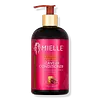What's inside
What's inside
 Key Ingredients
Key Ingredients

 Benefits
Benefits

 Concerns
Concerns

 Ingredients Side-by-side
Ingredients Side-by-side

Water
Skin ConditioningBehentrimonium Methosulfate
Cetyl Alcohol
EmollientButylene Glycol
HumectantGlycerin
HumectantOrbignya Oleifera Seed Oil
EmollientMauritia Flexuosa Fruit Oil
Skin ConditioningCopaifera Officinalis Resin
MaskingAstrocaryum Murumuru Seed Butter
EmollientVaccinium Myrtillus Fruit Extract
Skin ConditioningSaccharum Officinarum Extract
MoisturisingAcer Saccharum Extract
Skin ConditioningCitrus Aurantium Dulcis Fruit Extract
MaskingCitrus Medica Limonum Fruit Extract
Skin ConditioningPunica Granatum Extract
AstringentBetaine
HumectantHexylene Glycol
EmulsifyingHoney
HumectantPyrus Malus Fruit Extract
Skin ConditioningCamellia Sinensis Leaf Extract
AntimicrobialHexapeptide-11
Skin ConditioningCitric Acid
BufferingParfum
MaskingPhenoxyethanol
PreservativeBenzoic Acid
MaskingEthylhexylglycerin
Skin ConditioningGlycereth-2 Cocoate
EmulsifyingWater, Behentrimonium Methosulfate, Cetyl Alcohol, Butylene Glycol, Glycerin, Orbignya Oleifera Seed Oil, Mauritia Flexuosa Fruit Oil, Copaifera Officinalis Resin, Astrocaryum Murumuru Seed Butter, Vaccinium Myrtillus Fruit Extract, Saccharum Officinarum Extract, Acer Saccharum Extract, Citrus Aurantium Dulcis Fruit Extract, Citrus Medica Limonum Fruit Extract, Punica Granatum Extract, Betaine, Hexylene Glycol, Honey, Pyrus Malus Fruit Extract, Camellia Sinensis Leaf Extract, Hexapeptide-11, Citric Acid, Parfum, Phenoxyethanol, Benzoic Acid, Ethylhexylglycerin, Glycereth-2 Cocoate
Water
Skin ConditioningAloe Barbadensis Leaf Juice
Skin ConditioningCetearyl Alcohol
EmollientGlycerin
HumectantSimmondsia Chinensis Seed Oil
EmollientCaprylic/Capric Triglyceride
MaskingBehentrimonium Chloride
PreservativePsidium Guajava Fruit Extract
AstringentTerminalia Ferdinandiana Fruit Extract
AntioxidantPersea Gratissima Oil
Skin ConditioningAnnona Muricata Fruit Extract
Skin ConditioningDipropylene Glycol
HumectantPhenoxyethanol
PreservativeEthylhexylglycerin
Skin ConditioningLeuconostoc/Radish Root Ferment Filtrate
AntimicrobialMaltodextrin
AbsorbentParfum
MaskingBenzyl Alcohol
PerfumingBenzyl Benzoate
AntimicrobialBenzyl Salicylate
PerfumingLimonene
PerfumingHydroxycitronellal
PerfumingWater, Aloe Barbadensis Leaf Juice, Cetearyl Alcohol, Glycerin, Simmondsia Chinensis Seed Oil, Caprylic/Capric Triglyceride, Behentrimonium Chloride, Psidium Guajava Fruit Extract, Terminalia Ferdinandiana Fruit Extract, Persea Gratissima Oil, Annona Muricata Fruit Extract, Dipropylene Glycol, Phenoxyethanol, Ethylhexylglycerin, Leuconostoc/Radish Root Ferment Filtrate, Maltodextrin, Parfum, Benzyl Alcohol, Benzyl Benzoate, Benzyl Salicylate, Limonene, Hydroxycitronellal
 Reviews
Reviews

Ingredients Explained
These ingredients are found in both products.
Ingredients higher up in an ingredient list are typically present in a larger amount.
Ethylhexylglycerin (we can't pronounce this either) is commonly used as a preservative and skin softener. It is derived from glyceryl.
You might see Ethylhexylglycerin often paired with other preservatives such as phenoxyethanol. Ethylhexylglycerin has been found to increase the effectiveness of these other preservatives.
Glycerin is already naturally found in your skin. It helps moisturize and protect your skin.
A study from 2016 found glycerin to be more effective as a humectant than AHAs and hyaluronic acid.
As a humectant, it helps the skin stay hydrated by pulling moisture to your skin. The low molecular weight of glycerin allows it to pull moisture into the deeper layers of your skin.
Hydrated skin improves your skin barrier; Your skin barrier helps protect against irritants and bacteria.
Glycerin has also been found to have antimicrobial and antiviral properties. Due to these properties, glycerin is often used in wound and burn treatments.
In cosmetics, glycerin is usually derived from plants such as soybean or palm. However, it can also be sourced from animals, such as tallow or animal fat.
This ingredient is organic, colorless, odorless, and non-toxic.
Glycerin is the name for this ingredient in American English. British English uses Glycerol/Glycerine.
Learn more about GlycerinParfum is a catch-all term for an ingredient or more that is used to give a scent to products.
Also called "fragrance", this ingredient can be a blend of hundreds of chemicals or plant oils. This means every product with "fragrance" or "parfum" in the ingredients list is a different mixture.
For instance, Habanolide is a proprietary trade name for a specific aroma chemical. When used as a fragrance ingredient in cosmetics, most aroma chemicals fall under the broad labeling category of “FRAGRANCE” or “PARFUM” according to EU and US regulations.
The term 'parfum' or 'fragrance' is not regulated in many countries. In many cases, it is up to the brand to define this term.
For instance, many brands choose to label themselves as "fragrance-free" because they are not using synthetic fragrances. However, their products may still contain ingredients such as essential oils that are considered a fragrance by INCI standards.
One example is Calendula flower extract. Calendula is an essential oil that still imparts a scent or 'fragrance'.
Depending on the blend, the ingredients in the mixture can cause allergies and sensitivities on the skin. Some ingredients that are known EU allergens include linalool and citronellol.
Parfum can also be used to mask or cover an unpleasant scent.
The bottom line is: not all fragrances/parfum/ingredients are created equally. If you are worried about fragrances, we recommend taking a closer look at an ingredient. And of course, we always recommend speaking with a professional.
Learn more about ParfumPhenoxyethanol is a preservative that has germicide, antimicrobial, and aromatic properties. Studies show that phenoxyethanol can prevent microbial growth. By itself, it has a scent that is similar to that of a rose.
It's often used in formulations along with Caprylyl Glycol to preserve the shelf life of products.
Water. It's the most common cosmetic ingredient of all. You'll usually see it at the top of ingredient lists, meaning that it makes up the largest part of the product.
So why is it so popular? Water most often acts as a solvent - this means that it helps dissolve other ingredients into the formulation.
You'll also recognize water as that liquid we all need to stay alive. If you see this, drink a glass of water. Stay hydrated!
Learn more about Water